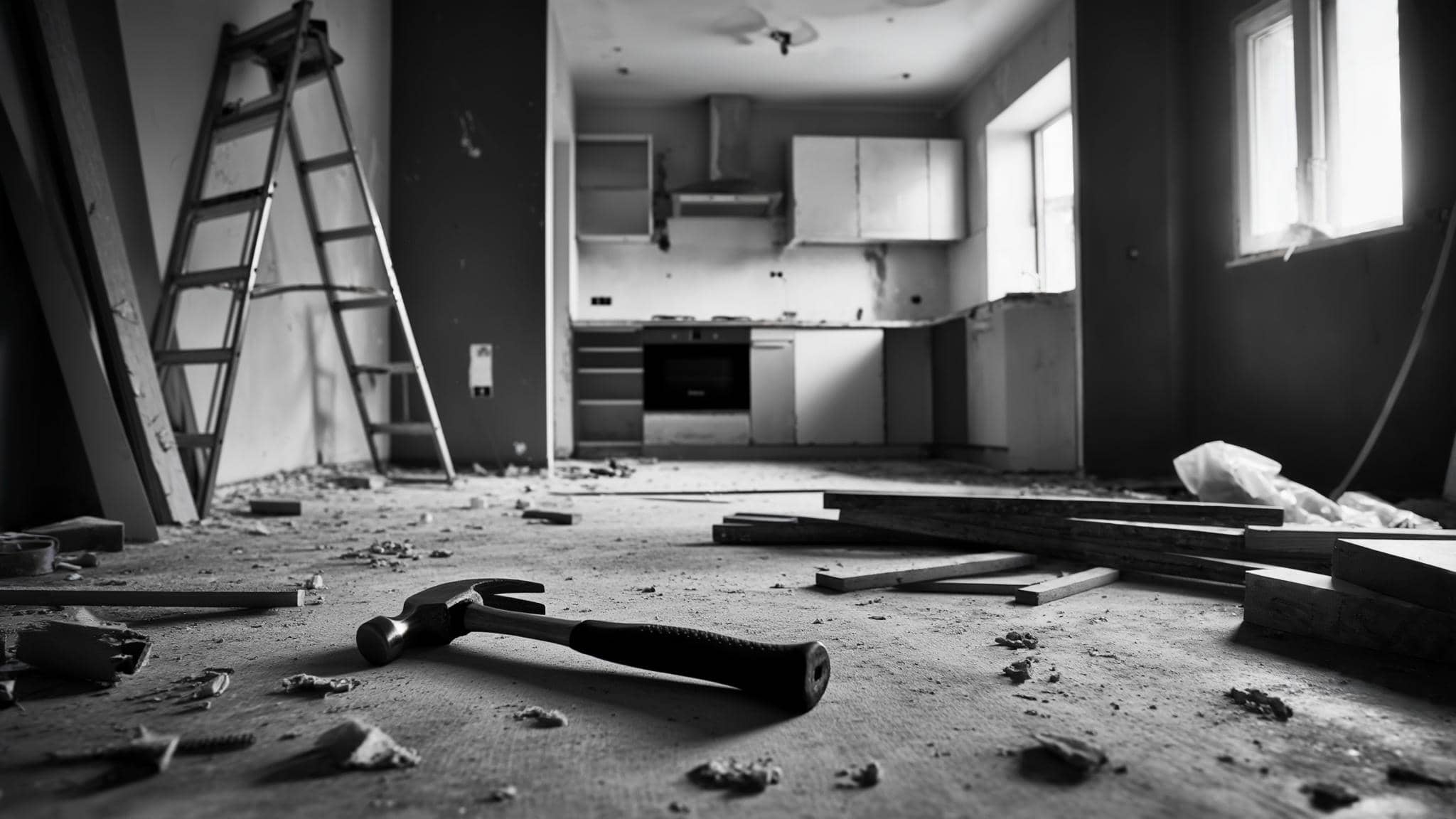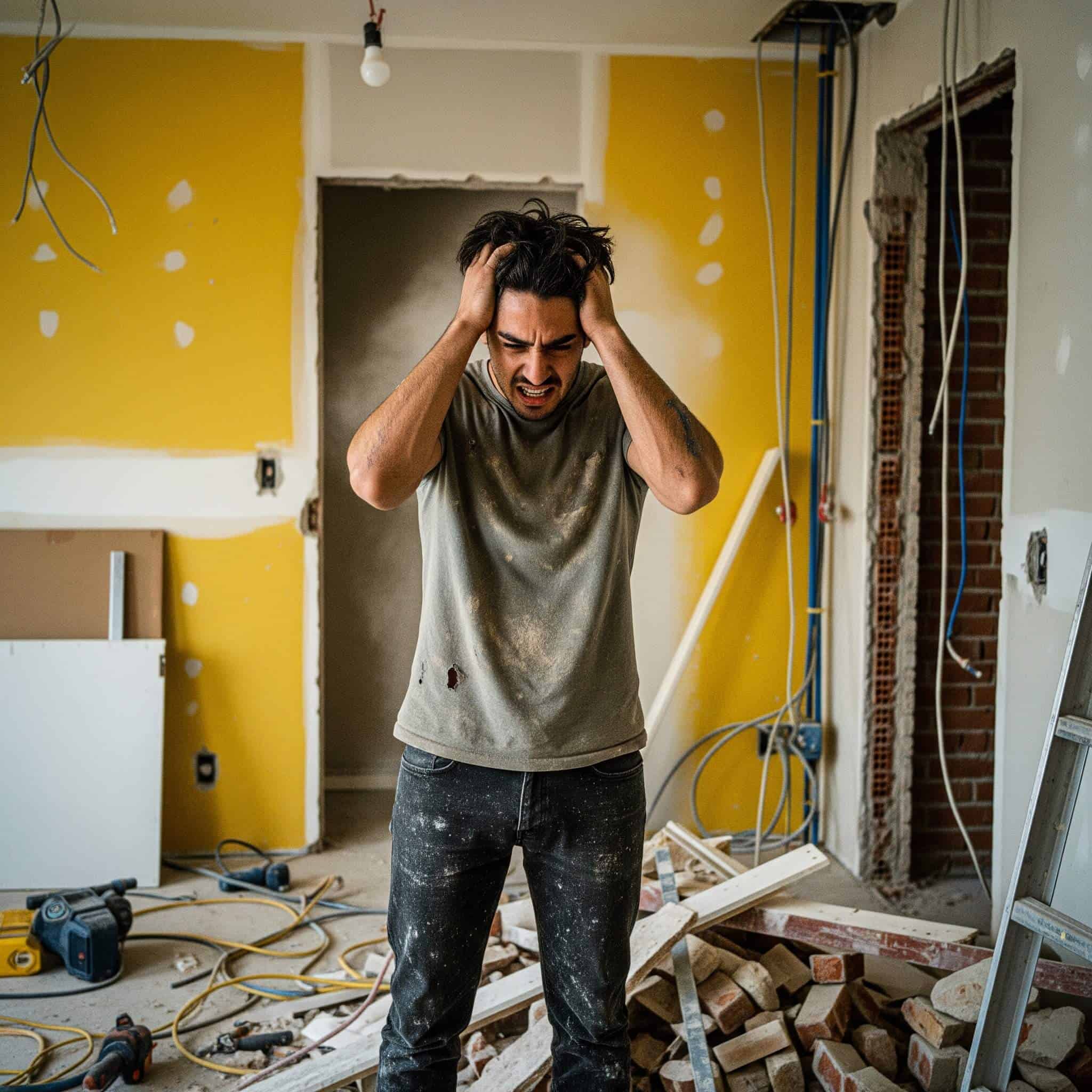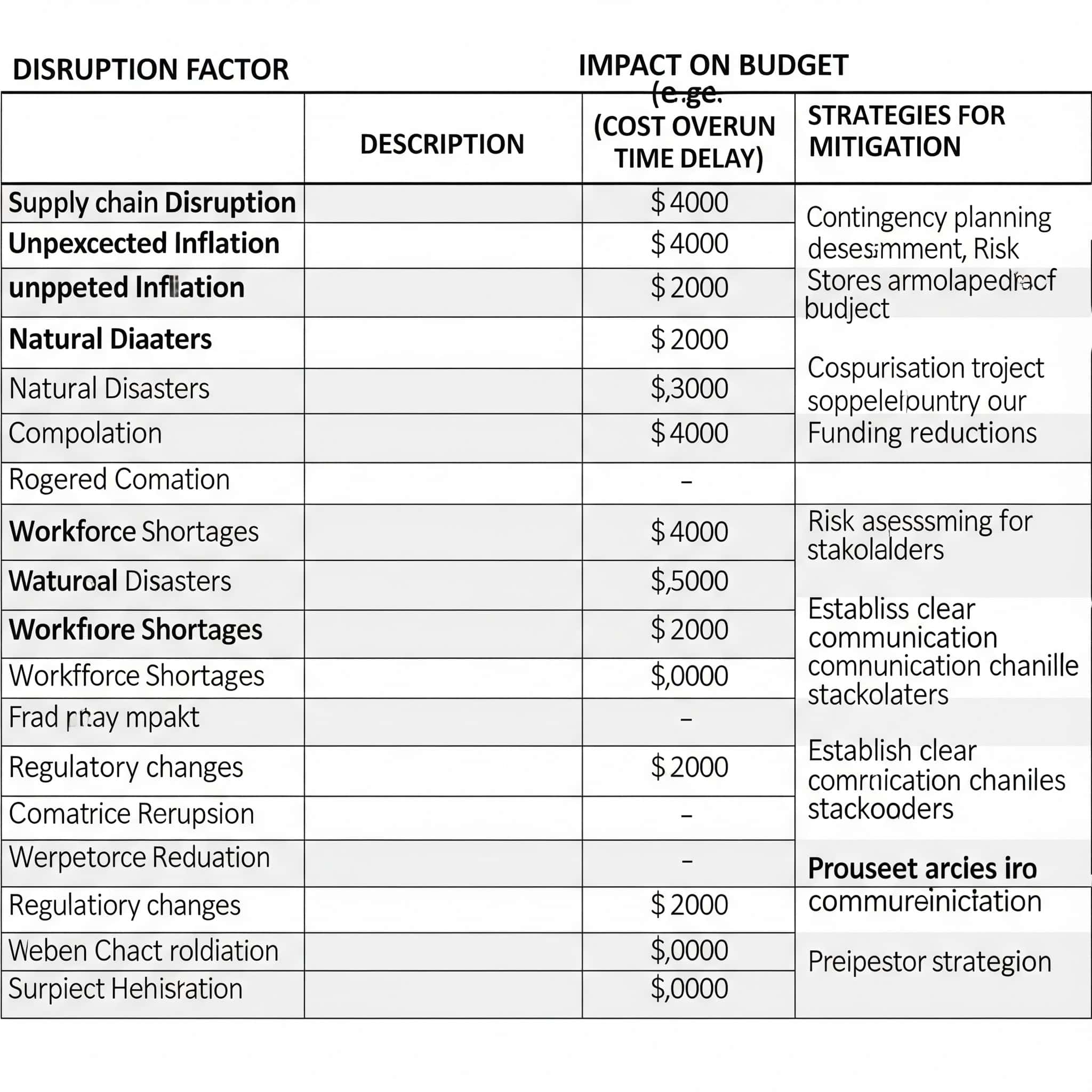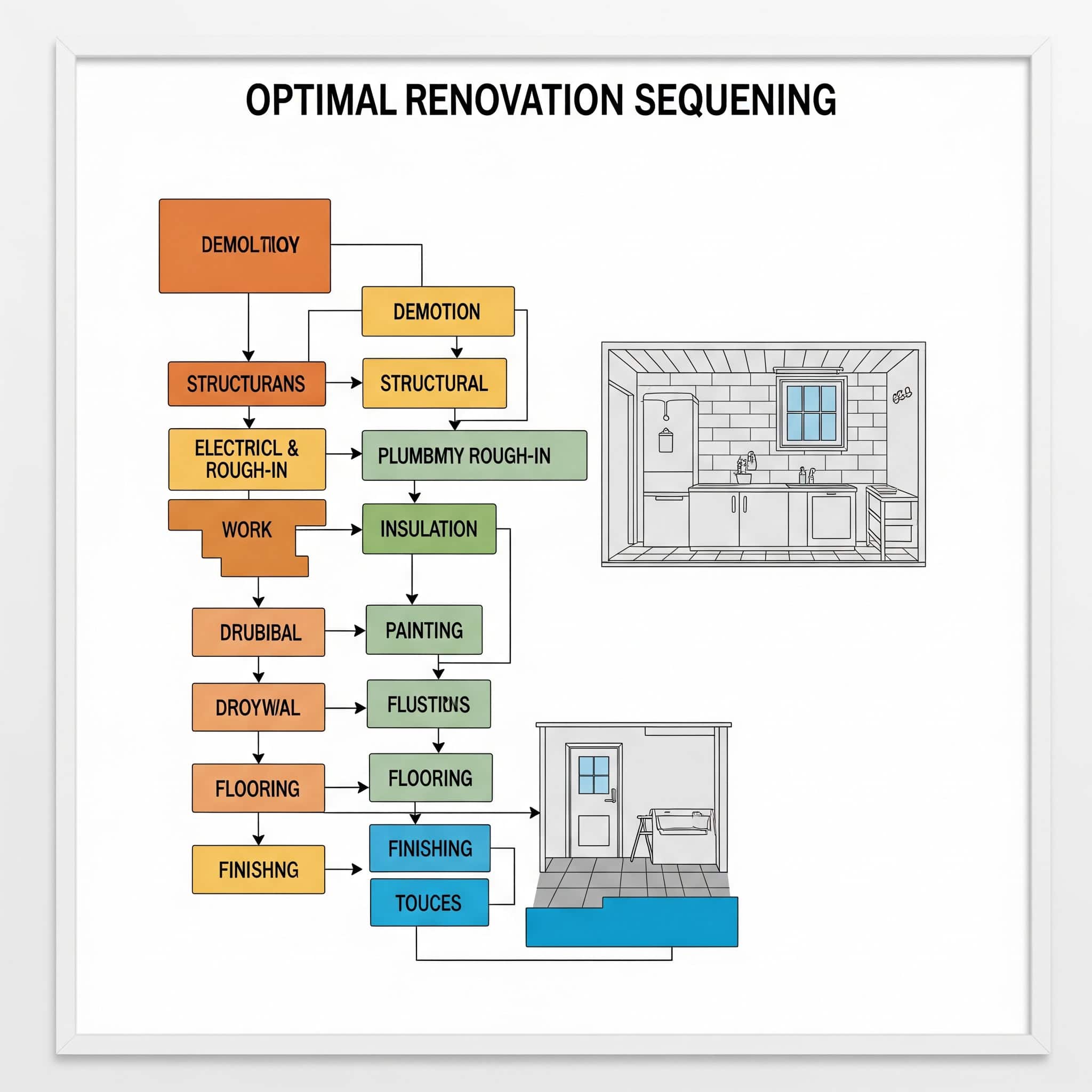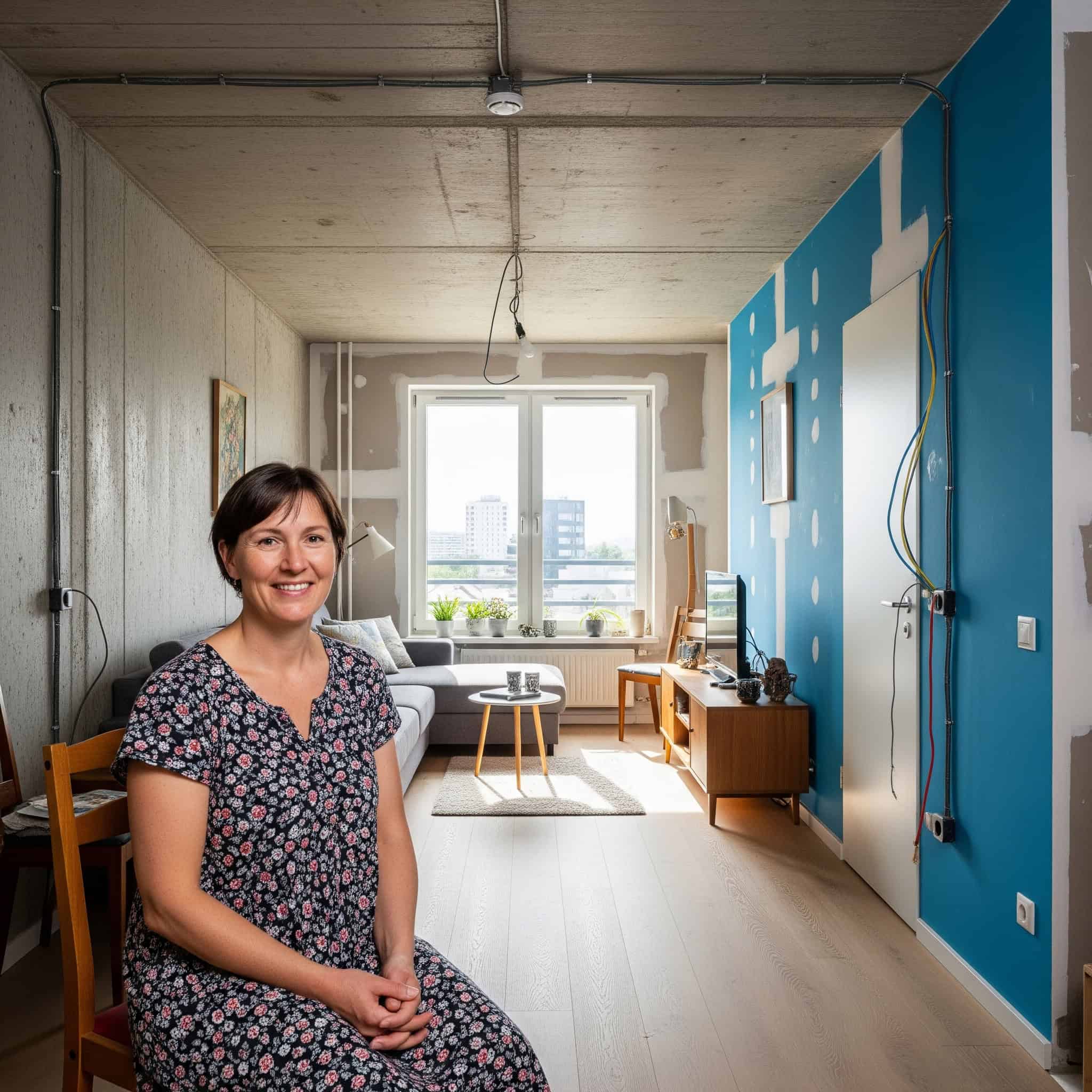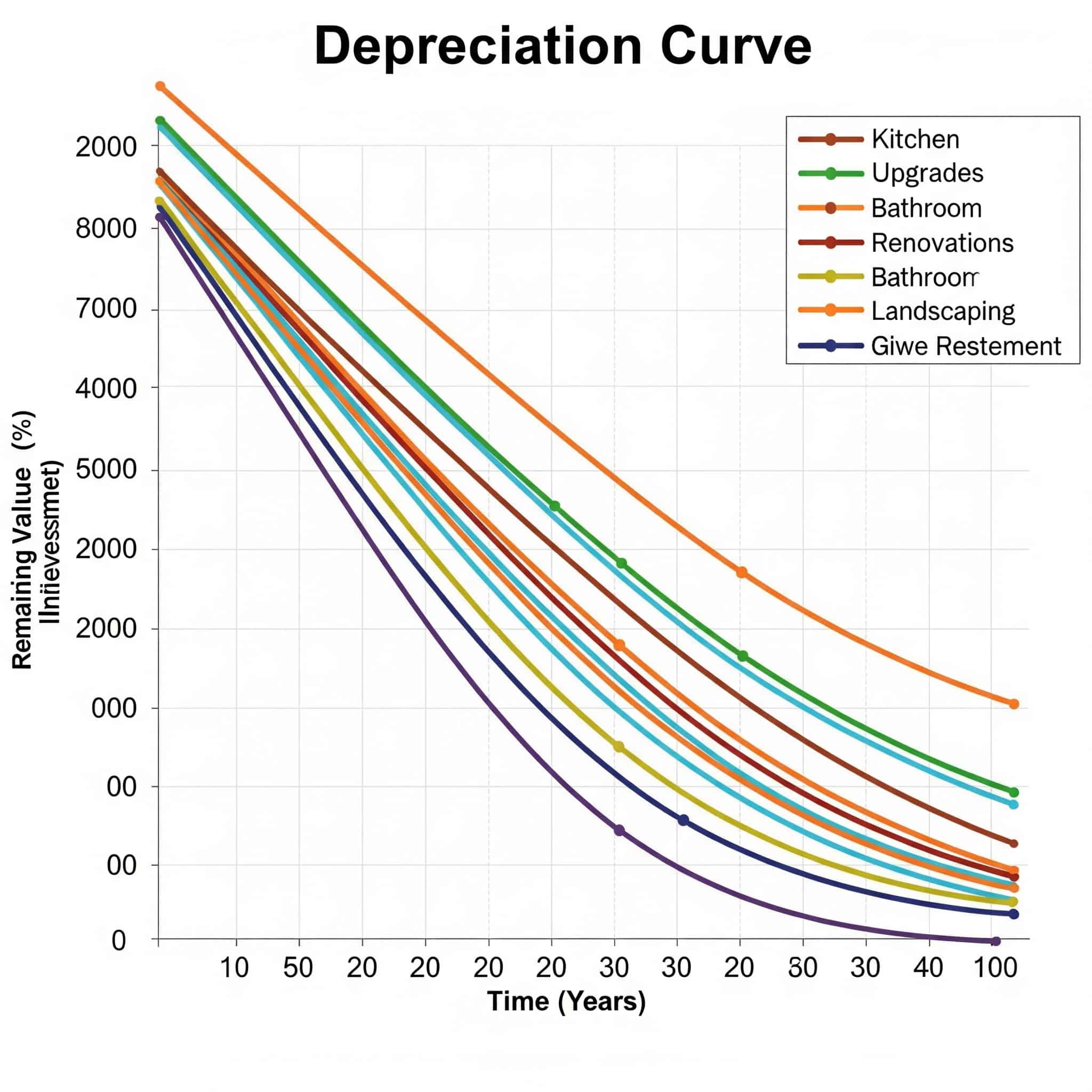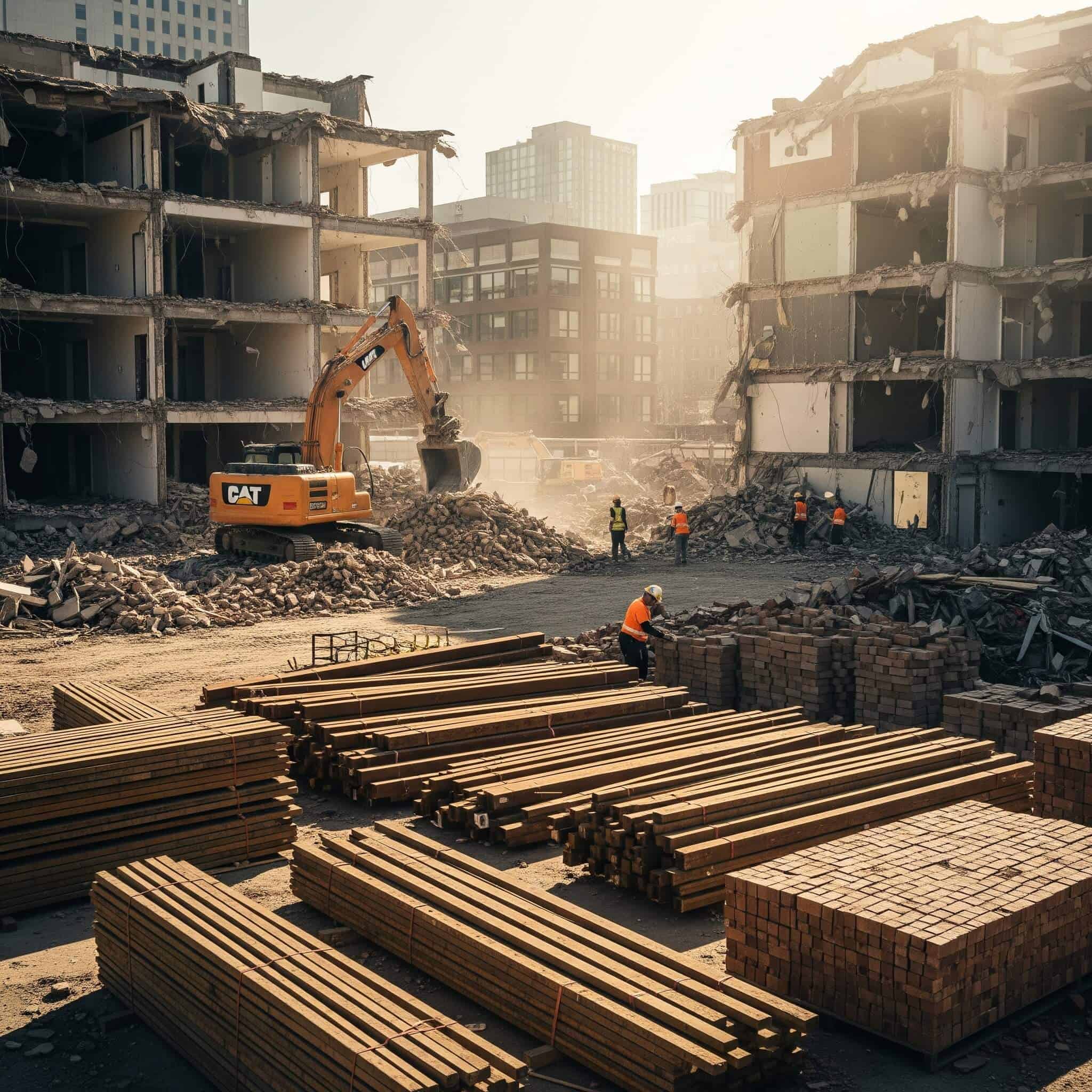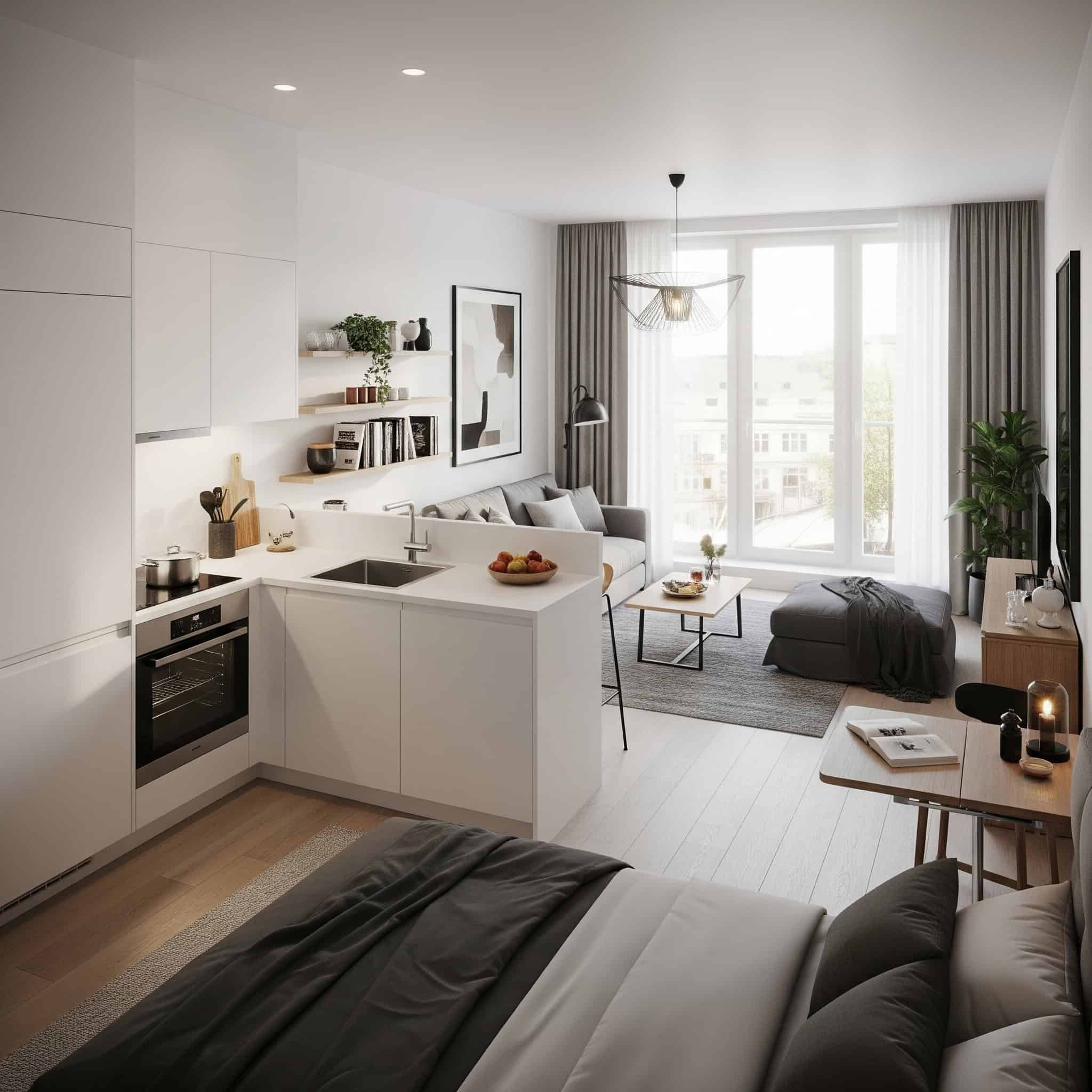The Ultimate Apartment Renovation Cost Guide: Hidden Expenses You Need to Know
Renovating an apartment involves more than just material and labor costs. According to a 2023 Houzz survey, 65% of homeowners exceed their renovation budgets by an average of 20%. I recently helped a client who thought they had budgeted perfectly, only to discover several hidden costs halfway through their project. This comprehensive guide explores the psychological, temporal, environmental, and labor economics of apartment renovations to help you create a realistic budget and avoid costly surprises.
Table of Contents
-
The Psychological Cost-Benefit Analysis
-
The Temporal Economics of Renovation
-
The Environmental Economics of Apartment Renovation
-
The Labor Economics of Renovation
-
Studio Apartment Renovation: Maximizing Value in Minimal Space
-
The Renovation Cost Lifecycle: Beyond Initial Expenditures
The Psychological Cost-Benefit Analysis
When planning your apartment renovation, you need to consider not just the financial costs but also the psychological impact. Renovation projects create stress, disrupt your routine, and require hundreds of decisions. These psychological factors have real economic consequences that should be factored into your budget planning to prevent unexpected costs and mental exhaustion.
Research indicates renovation-related stress can decrease productivity by up to 30% during projects, potentially costing thousands in lost income for professionals. This productivity drop isn’t something most people budget for, but it can significantly impact your bottom line, especially if you work from home.
The average apartment renovation requires making 300-500 decisions, creating significant cognitive load that impacts decision quality over time. I’ve seen clients become overwhelmed by the sheer number of choices they face, from paint colors to hardware finishes, leading to costly mistakes or rushed decisions.
Psychological costs can be quantified and budgeted for by allocating specific funds to stress management and decision support. Setting aside 5-10% of your budget as a “sanity buffer” might seem excessive, but it’s often the difference between a successful renovation and one that spirals out of control.
According to a 2023 Houzz survey, 65% of homeowners exceed their renovation budgets by an average of 20%, often due to psychological factors like decision fatigue and stress-induced changes.
Stress Economics in Renovation Planning
Renovation stress carries measurable costs that rarely appear in traditional budgets. The disruption to your daily life, noise, dust, and uncertainty all contribute to stress that can affect your work performance, health, and relationships. Quantifying these impacts allows you to make better decisions about project scope, timeline, and whether to remain in your home during renovation.
For every week of significant disruption, budget experts recommend adding 5-10% as a “sanity buffer” for temporary accommodations or stress-reducing services. This buffer isn’t just a luxury—it’s a practical acknowledgment that your ability to function normally will be compromised during renovation.
Productivity losses during renovation can be calculated by multiplying your hourly income by estimated productivity reduction percentage and project duration. For a professional earning $50/hour who experiences a 25% productivity drop during a four-week renovation, that’s a hidden cost of $2,000 that never appears on any contractor’s estimate.
Stress-related health impacts may include sleep disruption, increased illness susceptibility, and potential medical costs that should be factored into comprehensive budgeting. I’ve had clients who developed migraines or insomnia during their renovations, leading to additional expenses they never anticipated.
“In areas where renovation costs are lower, there’s less financial pressure, which allows clients to approach renovations with a sense of possibility rather than anxiety,” says Adrian Andronachi, founder of AGA Builders, as quoted in House Beautiful.
Calculating Your Stress Threshold
Everyone has different tolerance levels for renovation disruption. You need to honestly assess your personal threshold by evaluating how well you handle routine disruptions, noise sensitivity, and work-from-home requirements. This self-awareness helps you allocate appropriate funds for maintaining your wellbeing throughout the renovation process.
Create a disruption tolerance assessment by rating your sensitivity to noise, dust, schedule changes, and space limitations on a 1-10 scale. Be brutally honest with yourself—if you know you can’t function without your morning routine exactly as you like it, acknowledge that disruption will hit you hard.
Calculate your “sanity buffer” by multiplying your renovation budget by 0.05-0.10 based on your disruption tolerance score. This creates a dedicated fund for managing stress-related expenses that inevitably arise during renovation.
Document specific stress-mitigation strategies with associated costs, such as temporary housing ($100-200/night), meal delivery services ($15-30/meal), or noise-canceling equipment ($200-500). Having these options pre-planned prevents panic decisions when stress peaks.
|
Disruption Factor |
Low Sensitivity (1-3) |
Medium Sensitivity (4-7) |
High Sensitivity (8-10) |
|---|---|---|---|
|
Noise |
Add 2% to budget |
Add 5% to budget |
Add 8% to budget |
|
Dust/Air Quality |
Add 1% to budget |
Add 3% to budget |
Add 6% to budget |
|
Space Limitations |
Add 1% to budget |
Add 4% to budget |
Add 7% to budget |
|
Schedule Disruption |
Add 1% to budget |
Add 3% to budget |
Add 5% to budget |
|
Total Buffer |
5% of budget |
15% of budget |
26% of budget |
Time-Cost Trade-offs
Faster renovations typically cost more but reduce the duration of stress and disruption. You need to analyze whether paying premium rates for expedited work actually saves money when considering your productivity losses, relationship strain, and mental health impacts during extended renovation periods. This calculation varies significantly based on your income, work flexibility, and stress tolerance.
Expedited renovation work typically commands a 15-25% premium for evening, weekend, or overlapping trade scheduling. While this might seem expensive, the true calculation needs to include the hidden costs of a longer timeline.
Calculate your personal time-value by multiplying daily income by productivity reduction percentage to determine maximum worthwhile premium for faster completion. If you earn $400 daily and expect a 30% productivity drop during renovation, you could justify paying up to $120 per day to shorten the timeline.
Document productivity impacts using time-tracking tools during the first week of renovation to adjust projections for extended projects. This real-world data helps refine your calculations and may justify additional expenditure on expedited work if the impact is worse than anticipated.
Decision Fatigue Prevention
Decision fatigue is a real psychological phenomenon that affects your ability to make good choices as the number of decisions increases. In renovation projects, this can lead to poor choices, budget overruns, and regretted purchases. Implementing strategies to combat decision fatigue helps maintain decision quality throughout your project.
Pre-select finishes in categories (all lighting, all hardware, all paint) rather than room-by-room to reduce decision context-switching costs. This approach maintains your mental energy by focusing on similar choices together rather than jumping between different decision types.
Allocate 5-7% of your renovation budget for professional design consultation on high-visibility elements to prevent costly mistakes. Having an expert guide your most important decisions can prevent expensive errors and regretted choices.
Create a decision hierarchy document that identifies which choices impact structural integrity, which affect long-term functionality, and which are purely aesthetic to prioritize mental energy. This helps you focus your best thinking on decisions with lasting consequences.
Sarah, a marketing executive in Chicago, created a “decision calendar” for her one-bedroom apartment renovation. She dedicated specific days to different categories of decisions—Mondays for flooring options, Wednesdays for lighting fixtures, and Fridays for paint colors. By batching similar decisions together and spacing them throughout her three-month planning phase, she avoided the decision fatigue that had derailed her previous renovation attempt. This simple scheduling strategy saved her an estimated $3,500 in impulsive, poorly-considered purchases.
The Hidden Value of Renovation Sequencing
The order in which you renovate spaces significantly impacts your overall costs. Strategic sequencing prevents rework, reduces the chance of damaging newly renovated elements, and optimizes contractor scheduling. This approach is particularly important in apartment renovations where space constraints limit work areas and storage options.
Proper renovation sequencing can reduce total project costs by 10-15% compared to arbitrary ordering. I’ve seen clients save thousands simply by planning the right order of operations, preventing costly rework and damage to completed elements.
Critical path analysis identifies dependencies between renovation tasks to prevent costly work stoppages and trade scheduling conflicts. Understanding which tasks must precede others creates an efficient workflow that minimizes downtime and scheduling gaps.
Documentation of the optimal work sequence creates accountability for contractors and prevents costly deviation from the planned approach. Having this plan in writing helps everyone understand the logic behind the sequence and reduces the temptation to skip ahead to more visible or interesting tasks.
Flow-Based Renovation Planning
Mapping the physical and functional flow of your apartment helps determine the optimal renovation sequence. Starting with foundational systems like plumbing and electrical, then moving to shell improvements such as walls and floors, and finally to functional enhancements like cabinetry and fixtures prevents costly rework and minimizes damage to completed elements.
Create a renovation dependency map showing which elements must be completed before others can begin to optimize scheduling. This visual tool helps everyone understand the logical progression of work and prevents costly sequence errors.
Document “point of no return” milestones where changes become exponentially more expensive to implement. Identifying these critical points helps you finalize decisions when necessary while maintaining flexibility where possible.
Calculate rework risk costs by multiplying the probability of sequence-related damage by the replacement cost of each element. This calculation often reveals that proper sequencing is worth significant investment in planning and coordination.
Living-In-Place Strategies
If you must live in your apartment during renovation, you need a strategic plan to maintain some quality of life while managing costs. Creating a “renovation migration plan” designates specific zones for living while others are under construction, saving on alternative housing costs while preserving your sanity.
Zone-based renovation scheduling can save 10-20% on alternative housing costs while maintaining basic livability. By carefully planning which areas are under construction at any given time, you can maintain essential functions within your home throughout the renovation.
Create a containment strategy document specifying dust barriers, HVAC protection, and daily cleanup requirements to maintain livable conditions. These protocols protect both your health and completed work from construction dust and debris.
Calculate the minimum functional requirements for each living zone (electricity, water, food preparation, sleeping, hygiene) and ensure continuous access to at least one option for each. This approach maintains basic livability while allowing construction to proceed efficiently.
The Temporal Economics of Renovation
Traditional renovation budgeting focuses on immediate costs but fails to account for how renovation decisions play out over time. Understanding the temporal dimension helps you make choices that optimize long-term financial benefits rather than just minimizing upfront expenses. This approach considers how different elements age, depreciate, and affect property value over years or decades.
Different renovation elements have vastly different useful lifespans, from 5 years for trendy finishes to 30+ years for quality structural improvements. When you understand these varying timelines, you can allocate your budget more effectively to elements with lasting value.
Long-term cost analysis requires calculating the annualized cost of each element (purchase price divided by expected lifespan) rather than focusing solely on initial price. This approach often reveals that higher-quality items with longer lifespans actually cost less per year than budget options that require frequent replacement.
According to Sweeten general contractors, the typical price range for an entire home remodel in NYC is $100 to $200 per square foot, but this fails to account for long-term costs over the renovation’s lifecycle.
Renovation Depreciation Curves
Different renovation elements depreciate at vastly different rates. Understanding these patterns helps you allocate your budget to maximize long-term value rather than just immediate aesthetic impact. This knowledge prevents overspending on trendy items that quickly become dated while ensuring adequate investment in elements with lasting value.
Quality plumbing fixtures typically retain 60-80% of their value over the first decade, while trendy design elements may depreciate 50-70% within 3-5 years. This dramatic difference in value retention should guide your investment decisions.
Create a depreciation schedule for each major renovation element to calculate true annualized costs over your expected occupancy period. This approach reveals the hidden value of quality investments that maintain their worth over time.
Document expected maintenance requirements and costs for each element to calculate total lifecycle expenses beyond initial purchase price. Some seemingly affordable options require expensive ongoing maintenance that erases any initial savings.
The apartment renovation costs can vary dramatically depending on how you allocate your budget between quickly-depreciating trendy elements and slowly-depreciating quality investments.
High-Retention Value Elements
Some renovation investments maintain their value remarkably well over time. You should invest disproportionately in elements with slow depreciation curves: quality plumbing fixtures, solid hardwood flooring, and energy-efficient windows. These typically retain 60-80% of their value over the first decade, unlike trendy design elements that quickly become dated.
Quality plumbing fixtures have 15-20 year lifespans with minimal maintenance requirements, making their annualized cost significantly lower than budget options. While you might pay twice as much upfront, the per-year cost often works out lower when you consider the extended lifespan.
Solid hardwood flooring can last 25+ years with proper maintenance and can be refinished multiple times, reducing the effective annual cost to 1/3 of cheaper alternatives. This makes hardwood flooring one of the best long-term investments in apartment renovation.
Energy-efficient windows with 20+ year lifespans provide ongoing utility savings that offset their higher initial cost, creating positive return on investment within 7-10 years. These windows continue to deliver value through reduced energy bills long after they’ve paid for themselves.
Miguel and Elisa invested $4,800 in solid hardwood flooring for their 800-square-foot Brooklyn apartment instead of $2,200 for vinyl plank flooring. While the initial cost was more than double, the hardwood has been refinished twice over 18 years at $1,200 per refinishing. The vinyl alternative would have needed complete replacement every 6-8 years at full cost. Their total flooring expenditure over 18 years was $7,200 for hardwood versus an estimated $8,800 for vinyl replacements, proving that higher initial quality resulted in 18% savings over time.
Trend-Sensitive Elements
Highly visible, trend-sensitive elements like backsplashes, cabinet styles, and hardware require a different budgeting approach. You should either choose timeless designs or explicitly budget for replacement every 7-10 years. Allocating only 15-20% of your renovation budget to these elements prevents major financial waste when trends inevitably change.
Trend analysis of kitchen and bathroom design shows major style shifts occur approximately every 7-10 years, making trend-following choices a depreciating asset. What looks cutting-edge today may look dated within a decade, requiring replacement to maintain property value.
Create a “trend vulnerability index” for each design element by rating its visibility, style-specificity, and replacement difficulty on a 1-10 scale. This helps identify which elements should be timeless investments versus those where you can safely follow current trends.
Calculate the “timelessness premium” you’re willing to pay for classic designs by multiplying the replacement cost by the number of trend cycles during your expected occupancy. This often justifies paying more for enduring styles that won’t need frequent updating.
The 5/15/30 Rule for Studio Apartments
In studio apartment renovations, space limitations make visual impact particularly important. The 5/15/30 rule helps you prioritize investments based on visibility and function: elements visible from the entry should last 30 years, functional elements should last 15 years, and decorative elements should be refreshable every 5 years. This approach optimizes the small space’s visual impact while managing long-term costs.
Map your studio apartment’s visual hierarchy by identifying what elements are visible from the entry, during daily use, and only occasionally. This mapping helps prioritize quality investments in highly visible areas while allowing more economical choices in less prominent spaces.
Calculate the “visual impact ratio” of each element by dividing its visual prominence score by its cost to prioritize high-impact, long-lasting investments. This approach maximizes the perceived value of your studio apartment renovation cost while maintaining budget discipline.
Document the replacement difficulty factor for each element to avoid creating future renovation challenges through poor sequencing decisions. Some elements become nearly impossible to replace without disturbing others, making their durability particularly important.
Future-Proofing Investments
Strategic upfront investments in adaptable infrastructure can significantly reduce future renovation costs while increasing property value and functionality over time. Planning for technological changes, evolving needs, and potential upgrades saves substantial money compared to retrofitting these capabilities later.
Future-proofing typically adds 5-10% to initial renovation costs but can reduce future modification expenses by 30-50%. This relatively small upfront investment creates significant long-term savings while increasing property value and functionality.
Create a technology evolution forecast document identifying likely changes in home technology over the next 5-10 years to guide infrastructure planning. This forward-looking approach ensures your renovation accommodates emerging technologies rather than becoming quickly obsolete.
Calculate the “future access premium” for each building system by comparing initial installation costs to future retrofit expenses. This calculation often reveals that seemingly expensive accessibility features are actually bargains when compared to future retrofit costs.
“Our boiler’s old and it would be great to replace it with heat pumps but that requires at least some electric changes if not a full retrofit,” explains Dan Winckler, board president of a 60-unit prewar co-op in Brooklyn, as quoted in Habitat Magazine.
Technology Integration Planning
Technology needs in homes continue to evolve rapidly. Installing conduit systems and extra electrical capacity during initial renovations accommodates future technology without requiring wall demolition. This relatively small investment prevents costly repairs and upgrades as smart home technology continues to advance.
Installing empty conduit pathways during renovation costs $500-1000 but saves $3000-5000 in future wall repairs for technology upgrades. These pathways allow future cable runs without damaging finished surfaces, preserving both your investment and your sanity.
Document all in-wall infrastructure with detailed photographs and measurements before closing walls to facilitate future modifications. This documentation becomes invaluable when planning future upgrades or troubleshooting issues.
Create a capacity planning document specifying electrical load calculations, data transmission requirements, and expansion capabilities for each system. This ensures your infrastructure can accommodate future needs without costly upgrades.
Modular Design Approaches
Implementing modular design elements allows for easy updates without complete replacement. Examples include cabinet systems with replaceable door fronts, standardized lighting connections, and sectional flooring systems. This approach significantly reduces future renovation costs while allowing you to refresh your space as needs or preferences change.
Modular design approaches typically add 10-15% to initial costs but reduce future update expenses by 30-40%. This investment in flexibility pays dividends every time you want to update your space without a complete renovation.
Create a modularity specification document identifying standardized dimensions, connection types, and replacement procedures for each system. This documentation ensures future modifications can be made efficiently without compromising the original design.
Calculate the “partial replacement ratio” for each element by dividing the cost of component replacement by complete system replacement to quantify modularity benefits. This calculation often reveals substantial savings potential that justifies the initial modularity premium.
The Environmental Economics of Apartment Renovation
The environmental impact of renovation choices carries increasingly significant economic implications. Understanding sustainable renovation options leads to substantial cost savings while reducing environmental harm. This approach considers the full lifecycle of materials from production through disposal, identifying opportunities for both economic and environmental benefits.
Sustainable renovation approaches typically reduce waste disposal costs by 30-40% compared to conventional methods. These savings come from reduced landfill fees, potential material resale, and tax benefits from donations.
Energy-efficient improvements in apartments show faster payback periods than in larger homes due to concentrated living space. The smaller square footage means less material investment for greater efficiency returns.
When planning your apartment renovation, consider implementing eco-friendly junk removal practices as discussed in our guide on green junk removal strategies that can significantly reduce your environmental footprint.
The True Cost of Demolition
Traditional demolition accounts for approximately 30% of renovation costs but has hidden economic and environmental impacts rarely factored into budgets. A strategic approach to demolition and material reuse yields substantial savings through reduced disposal fees, potential tax benefits, and material resale opportunities.
Demolition waste typically costs $25-50 per cubic yard for disposal, creating significant expenses for even modest renovations. These costs can quickly add up, especially in urban areas where disposal fees are highest.
Selective deconstruction documentation can provide tax deduction opportunities for donated materials, potentially offsetting higher labor costs. The tax benefits from material donations can transform deconstruction from a cost center to a financial advantage.
Material recovery planning identifies high-value salvageable items that can be resold or repurposed, creating direct financial returns from careful demolition. Items like hardwood flooring, quality fixtures, and solid wood cabinetry often retain significant resale value.
According to Intrabuild, demolition costs for apartment renovations range from $1,063 to $20,000, making it one of the most variable and potentially expensive initial phases of renovation.
Deconstruction vs. Demolition
Selective deconstruction costs 15-20% more upfront than traditional demolition but recovers 25-40% of those costs through material resale, tax deductions for donations, and reduced disposal fees. Creating an inventory of salvageable items before beginning your renovation helps you identify opportunities for significant savings.
Hardwood flooring, solid wood cabinetry, and quality fixtures typically retain 30-50% of their original value when carefully removed for reuse. These materials can be sold directly or donated for tax benefits, offsetting the higher labor costs of careful removal.
Create a salvage inventory document identifying potential value, removal requirements, and resale/donation options for each reusable element. This planning document transforms waste into assets and guides the deconstruction process.
Calculate net deconstruction costs by subtracting material resale value and tax deduction benefits from the gross deconstruction expense. This calculation often reveals that careful deconstruction costs less than traditional demolition when all factors are considered.
Disposal Cost Optimization
Renovation waste disposal typically accounts for 5-10% of total renovation costs. You can reduce these expenses by separating waste streams (metals, wood, concrete, general debris) and scheduling targeted pickups. This approach reduces disposal costs by 30-40% compared to general construction dumpster rental while supporting better environmental outcomes.
Metal recycling typically pays $0.05-0.50 per pound depending on the material, converting waste into direct income. Separating valuable metals from general construction waste can generate hundreds of dollars in recycling revenue.
Create a waste stream management plan identifying separation requirements, storage locations, and pickup scheduling for each material category. This organization maximizes recycling opportunities while minimizing disposal costs.
Calculate disposal cost savings by comparing separated waste stream expenses to general construction waste disposal rates for your project volume. This comparison often reveals thousands in potential savings for larger renovations.
For efficient management of renovation debris, explore our comprehensive guide on waste removal services that can help you properly dispose of different material types while staying environmentally conscious.
|
Waste Material |
Traditional Disposal |
Strategic Disposal |
Potential Savings |
|---|---|---|---|
|
Metal Fixtures |
$50-100/ton |
$50-500 income/ton |
$100-600 |
|
Wood Materials |
$70-120/ton |
$30-50/ton |
$40-70/ton |
|
Concrete/Masonry |
$80-150/ton |
$20-40/ton |
$60-110/ton |
|
Cabinets/Furniture |
$200-300/item |
$0-50/item with donation |
$150-300/item |
|
Appliances |
$50-100/item |
$0-100 income/item |
$50-200/item |
Energy Efficiency ROI Calculations
Energy-efficient renovations typically command a 10-25% premium but offer calculable returns that make them economically advantageous over time. This is particularly true in apartment settings where efficiency improvements are concentrated in smaller spaces, creating faster payback periods than in larger homes.
Energy-efficient improvements in apartments show 15-30% faster payback periods than identical improvements in larger homes due to concentrated living space. The smaller area means less material investment for greater efficiency returns.
Create an energy efficiency investment hierarchy based on return-on-investment calculations for each potential improvement. This prioritization ensures you tackle the highest-return improvements first, maximizing your efficiency budget.
Document baseline energy consumption before renovation to accurately measure improvement impacts and validate ROI projections. This before-and-after comparison provides concrete evidence of your efficiency investments’ value.
The Insulation Value Proposition
In apartment renovations, strategic insulation upgrades in shared walls, floors, and ceilings offer dual benefits: energy savings and sound attenuation. This combination is particularly valuable in multi-unit buildings where noise transfer significantly impacts quality of life. Calculating your return on investment requires considering both energy savings and quality of life improvements.
Acoustic insulation in shared walls typically reduces sound transmission by 50-70% while improving thermal performance by 20-30%. This dual benefit makes insulation one of the highest-value investments in apartment renovations.
Calculate your insulation ROI using: (Annual Energy Savings + Quality of Life Value) ÷ Insulation Cost = ROI Percentage. The quality of life value might seem subjective, but most people can assign a dollar value to peaceful, quiet living space.
Document insulation specifications and installation details for future reference, as these improvements are typically concealed within finished walls. This documentation proves valuable for future renovations or when selling your property.
Appliance Efficiency Economics
Energy-efficient appliances typically cost 15-30% more than standard versions but offer payback periods of 3-7 years in energy savings. For apartment renovations, you should prioritize refrigerators and HVAC systems, which together represent up to 70% of an apartment’s energy usage and offer the fastest efficiency payback.
Energy Star refrigerators use approximately 15% less energy than standard models, saving $30-60 annually in electricity costs. Over a typical 10-15 year lifespan, these savings more than offset the higher purchase price.
Create an appliance efficiency comparison spreadsheet calculating lifetime energy costs plus purchase price to identify true cost of ownership. This calculation often reveals that the most affordable option at purchase becomes the most expensive over time.
Document expected appliance lifespans and replacement schedules to plan for future upgrades at optimal intervals. This forward-looking approach prevents emergency replacements and allows for strategic upgrading when technology improvements justify the investment.
When upgrading your kitchen during renovation, consider proper appliance disposal methods as outlined in our guide on refrigerator disposal laws and guidelines to ensure environmental compliance.
Window Economics Beyond Energy
When calculating the ROI on window replacements, include non-energy factors: reduced dust infiltration, improved soundproofing, and increased property valuation. These factors can shorten the effective payback period from 10-15 years to 5-8 years, making window replacement a more attractive investment than energy savings alone would suggest.
Quality window replacements typically recoup 70-80% of their cost in immediate property value increases, creating substantial instant return. This immediate value boost significantly improves the economic case for window replacement.
Calculate comprehensive window ROI by adding energy savings, cleaning cost reduction, noise reduction value, and property value increase, then dividing by installation cost. This holistic approach reveals the true value of quality windows beyond simple energy calculations.
Document window performance specifications including U-factor, Solar Heat Gain Coefficient, and Sound Transmission Class for warranty and future reference. These specifications prove valuable for insurance claims, future sales, and warranty service.
The Labor Economics of Renovation
Understanding renovation labor economics leads to significant cost savings without sacrificing quality. Simply comparing hourly rates fails to account for efficiency differences, expertise value, and relationship economics that ultimately determine true labor costs. This knowledge helps you make better hiring decisions and manage labor expenses effectively.
Labor typically represents 30-50% of total renovation costs, making it the largest single expense category. Despite this significance, many renovators focus primarily on material selection while giving less attention to labor optimization.
Contractor selection based solely on hourly rates often results in 25-40% higher total costs due to efficiency and quality factors. The cheapest hourly rate rarely translates to the lowest total cost when all factors are considered.
The apartment renovation cost can be significantly reduced through strategic labor management without compromising quality or timeline. Understanding the true economics of renovation labor helps you make better hiring decisions and manage this major expense category effectively.
Specialist vs. Generalist Economics
The decision to hire specialists versus generalists for various renovation tasks has profound economic implications beyond simple hourly rate comparisons. Understanding the true cost requires considering completion time, error rates, and rework probability to determine whether specialist premiums are justified for each project component.
Specialists typically complete tasks 40-60% faster than generalists while reducing error rates by 70-80%. This dramatic efficiency difference often more than offsets their higher hourly rates.
Calculate true labor costs using: (Hourly Rate × Hours) + (Error Probability × Rework Cost) to determine actual expense expectations. This formula reveals the hidden costs of seemingly affordable labor options.
Document specialist vs. generalist decision criteria for each project component based on complexity, visibility, and performance requirements. This approach ensures you use specialists where they add value while saving money with generalists on appropriate tasks.
Alex hired a general contractor at $45/hour to install custom kitchen cabinets in his Manhattan apartment, expecting to save money compared to a cabinet specialist charging $75/hour. The generalist took 32 hours ($1,440) but made several measurement errors requiring $800 in materials and 12 additional hours ($540) to correct. The specialist would have completed the error-free installation in 18 hours for $1,350 total. Alex’s attempt to save money by choosing the lower hourly rate ultimately cost him $1,430 more than hiring the specialist.
The Efficiency Premium Calculation
Specialists typically charge 30-50% more per hour than generalists but often complete tasks in 40-60% less time while reducing error rates by 70-80%. Calculating the true cost requires considering both time efficiency and quality outcomes to determine whether the specialist premium is justified for each project component.
Create an efficiency comparison worksheet documenting estimated completion times and quality expectations for specialists vs. generalists on each project component. This analysis helps identify which tasks justify specialist premiums and which don’t.
Calculate the “efficiency premium threshold” at which specialist hourly rates become economically advantageous based on time savings and reduced rework. This calculation often reveals that specialists are more affordable than they initially appear.
Document quality standards and acceptance criteria for each work component to ensure objective evaluation of completed work. These standards prevent disputes and ensure you receive the quality you’re paying for.
The Sequencing Advantage
Specialists can work concurrently on different aspects of your renovation, whereas generalists must work sequentially. For an average apartment renovation, this can reduce project timeline by 30-40%, significantly decreasing the indirect costs associated with prolonged renovations such as alternative housing, storage, and extended disruption.
Create a trade sequencing diagram showing potential concurrent work opportunities to optimize project scheduling. This visual tool helps identify opportunities to compress the timeline through strategic scheduling.
Calculate the “time compression value” of concurrent work by multiplying daily carrying costs (alternative housing, storage, lost productivity) by days saved. This calculation often reveals thousands in potential savings through timeline optimization.
Document critical path dependencies between different trades to prevent scheduling conflicts and work stoppages. This planning prevents the costly domino effect of scheduling errors that plague many renovation projects.
The Economics of Relationship Capital
Building strategic relationships with contractors and suppliers yields substantial cost savings beyond simple price negotiations. This approach is particularly valuable for apartment renovations where space constraints create unique challenges requiring flexible, responsive service providers who understand your specific needs.
Established contractor relationships typically yield 5-15% cost savings through preferred pricing, priority scheduling, and reduced communication overhead. These savings come from the contractor’s reduced risk and acquisition costs when working with established clients.
Calculate the value of contractor loyalty by comparing pricing, responsiveness, and quality consistency between new and established service providers. This comparison often reveals significant advantages beyond simple pricing.
Document relationship development strategies including referral offers, testimonial opportunities, and communication preferences. This intentional approach transforms relationships from accidental to strategic assets.
Contractor Loyalty Programs
You can establish valuable relationships with contractors by offering referrals, testimonials, and social media promotion in exchange for priority scheduling and preferred pricing. Contractors typically offer 5-15% discounts to clients who help build their business through referrals, as new client acquisition costs average 20-25% of project revenue.
Create a contractor relationship document specifying referral arrangements, testimonial agreements, and expected preferential treatment. This explicit agreement ensures both parties understand the value exchange.
Calculate the value of priority scheduling by multiplying daily carrying costs by estimated schedule advancement. In tight construction markets, priority scheduling can be worth thousands in avoided alternative housing or extended storage costs.
Document contractor performance metrics including response time, work quality, and problem resolution to ensure relationship investment is justified. This performance tracking ensures your loyalty is directed to contractors who truly deliver value.
Supplier Relationship Economics
Developing direct relationships with material suppliers rather than relying solely on contractor-sourced materials can reduce costs by 10-30%. This approach gives you access to discontinued items, remnants, and overstock that may be perfect for apartment-scale projects where quantities needed are often smaller than typical residential renovations.
Create a supplier contact database documenting specialty areas, remnant availability, and discount structures for each vendor. This resource becomes increasingly valuable as you develop relationships with multiple suppliers.
Calculate material cost savings by comparing direct purchase prices (including delivery) to contractor-supplied material costs. This comparison often reveals significant savings potential, especially for finish materials.
Document material specifications and sources for future reference and warranty claims. This documentation proves invaluable for maintenance, repairs, and future matching of materials.
Studio Apartment Renovation: Maximizing Value in Minimal Space
Studio apartment renovations present unique economic challenges and opportunities due to their limited square footage. Each design decision carries heightened importance when space is at a premium. Understanding the specific cost dynamics of these compact spaces helps optimize investment while avoiding common pitfalls that lead to budget overruns.
Studio renovations typically cost 15-25% more per square foot than larger apartments due to space constraints and specialized solutions. The limited working area creates logistical challenges that increase labor costs while requiring more customized approaches.
Multi-functional design elements deliver 1.5-2x more value in studios compared to conventional spaces due to space optimization benefits. This value multiplier justifies premium investments in versatile solutions that would be unnecessary in larger apartments.
Space-Value Optimization Strategies
In studio renovations, each square foot carries premium value compared to larger apartments. Effective renovation requires maximizing functional value per square inch rather than applying traditional renovation approaches. This means prioritizing investments that create visual spaciousness and multi-functionality over conventional upgrades.
Calculate the “functional density value” of each renovation element by dividing its utility score by the square footage it occupies. This metric helps identify high-value investments that deliver maximum functionality in minimal space.
Document space utilization before and after renovation to quantify improvements in functional square footage. This before-and-after comparison provides concrete evidence of your renovation’s value.
Create a space-value hierarchy identifying which elements deliver the highest return in perceived and functional space enhancement. This prioritization ensures your budget focuses on improvements with maximum impact.
Visual Expansion Investments
You should allocate 15-20% of your studio renovation budget to elements that create visual spaciousness: strategic mirror placement, continuous flooring without transitions, and ceiling treatments that draw the eye upward. These investments typically yield a 1.5-2x return in perceived space value compared to pure functional upgrades.
Strategic mirror placement can increase perceived space by 30-40% when positioned to reflect natural light and extend sight lines. This relatively affordable intervention creates dramatic improvements in perceived spaciousness.
Calculate the “visual expansion ratio” of each design element by rating its impact on perceived spaciousness on a 1-10 scale divided by its cost. This calculation helps identify high-impact, cost-effective interventions.
Document sight line improvements by mapping visual paths before and after renovation to quantify perception enhancements. This analysis helps optimize mirror placement and other visual expansion strategies.
Multi-Function Premium Calculation
For studios, multi-functional elements command a justifiable premium. Custom solutions like murphy beds with integrated storage typically cost 2-3x more than standard alternatives but save $4,000-7,000 in additional furniture costs while preserving valuable floor space. You need to calculate the “space liberation value” to determine if premium solutions are worth the investment.
Calculate “space liberation value” by multiplying saved square footage by your per-square-foot rent/ownership cost. In high-value real estate markets, each square foot saved can be worth hundreds of dollars annually.
Document multi-functionality ratios for each element by counting distinct functions provided divided by square footage occupied. This metric helps identify truly efficient solutions versus merely compact ones.
Create a space utilization map showing how multi-functional elements transform the same square footage throughout different daily activities. This visualization helps justify premium investments in versatile solutions.
The Economics of Zoning in Studio Renovations
Creating distinct functional zones within a studio significantly increases its value and livability but requires careful cost-benefit analysis to execute effectively without physical walls. Understanding the economic implications of different zoning approaches helps you create functional separation without sacrificing the benefits of open space.
Effective zoning strategies typically increase studio apartment values by 10-15% compared to undifferentiated open layouts. This value increase often exceeds the cost of implementing thoughtful zoning solutions.
Calculate zoning ROI by comparing the cost of zone-creating elements to the functionality and value improvements they provide. This analysis helps identify the most cost-effective zoning strategies for your specific space.
Document zone transition strategies that maintain visual continuity while creating functional separation. These transitions are critical to successful studio zoning without creating a choppy, disconnected feel.
Light Architecture Solutions
Instead of costly full walls, you should invest in “light architecture” elements—partial walls, ceiling treatments, flooring transitions, and lighting zones—that define spaces without consuming precious square footage. These approaches typically cost 30-40% less than traditional room divisions while preserving openness and natural light flow.
Partial walls typically cost $500-1,500 compared to $1,500-3,000 for full walls while preserving light flow and visual connection. These light architecture elements create functional separation without the drawbacks of complete walls.
Calculate the “openness preservation value” of light architecture by comparing the light reduction percentage of traditional walls versus alternative solutions. This calculation helps quantify the benefits of maintaining an open feel.
Document sight line preservation strategies that maintain visual spaciousness while creating functional separation. These strategies are critical to successful studio zoning that enhances rather than diminishes perceived space.
Acoustic Management Value
In studios, sound management carries heightened economic value. Strategic acoustic treatments (sound-absorbing panels disguised as art, acoustic curtains, specialized insulation in key areas) typically add $1,500-2,500 to renovation costs but significantly increase livability and property value, especially in urban settings where noise pollution impacts quality of life.
Acoustic treatments can reduce ambient noise by 30-50% and improve speech privacy between zones by 40-60%. These improvements dramatically enhance livability in compact spaces where activities occur in close proximity.
Calculate acoustic ROI by assigning value to noise reduction based on location factors (urban vs. suburban) and proximity to noise sources. This calculation helps justify acoustic investments based on your specific situation.
Document decibel measurements before and after acoustic improvements to quantify performance and justify investment. These measurements provide concrete evidence of your acoustic treatments’ effectiveness.
Scale-Appropriate Material Economics
Studio renovations benefit from unique material economics due to their smaller dimensions. This opens opportunities for premium materials that would be prohibitively expensive in larger spaces. Understanding these scale advantages helps you maximize quality within budget constraints.
Studio apartments typically require 30-50% less material than one-bedroom units, creating opportunities for premium material use within similar budget constraints. This scale advantage allows for higher quality within comparable budgets.
Calculate the “premium material threshold” at which higher-quality materials become economically viable due to reduced quantity requirements. This calculation often reveals surprising opportunities for luxury materials in compact spaces.
Document material quantity requirements precisely to take advantage of remnant and small-lot pricing opportunities. This precision prevents over-ordering while ensuring adequate materials for your project.
Remnant Market Advantages
The dimensions of studio apartments often align perfectly with stone, quartz, and hardwood remnants, which typically sell for 40-60% less than full slabs or bundles. You should develop relationships with fabricators and flooring suppliers to access their remnant inventory, potentially saving thousands on premium materials that would otherwise exceed your budget.
Stone remnants typically sell for $25-40 per square foot compared to $60-100 for full slabs, creating significant savings opportunities. These remnants are often perfect for studio-sized countertops and backsplashes.
Create a remnant sourcing strategy document identifying local fabricators, their inventory turnover rates, and notification preferences. This proactive approach helps you access the best remnants before they’re claimed.
Calculate remnant size requirements with precise measurements plus 10-15% overage to ensure adequate material while minimizing waste. This precision is critical when working with limited remnant dimensions.
Vertical Surface Value Calculation
In studios, vertical surfaces occupy a larger percentage of visual field than in conventional apartments. You should reallocate 10-15% of your flooring budget to wall treatments to maximize visual impact per dollar spent. This approach delivers 1.5-2x more perceived value in compact spaces where walls dominate the visual experience.
Wall treatments typically cost $2-10 per square foot compared to $5-20 for quality flooring, potentially delivering more visual impact at lower cost. This cost advantage makes wall treatments particularly valuable in studio renovations.
Calculate the “visual prominence ratio” of vertical versus horizontal surfaces in your specific studio layout to optimize material allocation. This analysis helps determine the ideal budget distribution between floors and walls.
Document sight line analysis identifying which wall surfaces have highest visibility and visual impact to prioritize premium treatments. This targeting ensures your investment focuses on the most impactful surfaces.
The Renovation Cost Lifecycle: Beyond Initial Expenditures
Traditional renovation budgeting focuses exclusively on upfront costs, neglecting ongoing and future expenses that significantly impact the true economic picture. Understanding the complete cost lifecycle reveals opportunities for strategic investment and long-term savings that may justify higher initial expenditures for quality materials and workmanship.
Lifecycle costing typically reveals that initial expenses represent only 40-60% of total ownership costs over a 10-year period. The remaining costs come from maintenance, repairs, cleaning, and eventual replacement.
Maintenance, cleaning, repairs, and eventual replacement costs often exceed initial purchase price for many renovation elements. This reality makes apparent bargains into long-term burdens when the full lifecycle is considered.
After completing your renovation, you’ll likely need to dispose of old furniture and materials, which is where our furniture removal services can help ensure proper disposal while minimizing environmental impact.
Maintenance Coefficient Planning
Different renovation choices carry vastly different maintenance requirements and associated costs. Factoring these into initial decisions can dramatically alter the apparent value of various options. Low-maintenance materials and designs often justify premium pricing through reduced ongoing expenses and extended useful life.
Create a maintenance requirement document specifying cleaning procedures, frequency, and estimated time/material costs for each renovation element. This documentation helps quantify the ongoing costs of different material choices.
Calculate the “maintenance coefficient” for each material option by dividing annual maintenance costs by initial purchase price. This ratio helps identify which materials require disproportionate maintenance relative to their initial cost.
Document expected maintenance skill requirements to identify which tasks require professional service versus DIY maintenance. This analysis helps anticipate true maintenance costs based on your skills and preferences.
For comprehensive maintenance of your newly renovated space, consider our guide on house cleaning checklists that can help preserve your investment and extend the life of your renovation work.
Low-Maintenance Premium Assessment
You need to calculate the true cost difference between standard and low-maintenance options by multiplying annual maintenance costs by your expected tenancy/ownership duration. For example, natural stone countertops requiring annual sealing and specialized cleaning products might cost $150-300 annually in maintenance, making quartz alternatives economically superior over a 5+ year timeframe despite higher initial costs.
Create a maintenance cost comparison spreadsheet documenting annual expenses for each material option under consideration. This comparison reveals the true cost difference between high-maintenance and low-maintenance alternatives.
Calculate the “maintenance break-even point” at which higher initial costs for low-maintenance options are fully offset by reduced ongoing expenses. This calculation often reveals surprisingly short payback periods for premium, low-maintenance materials.
Document maintenance requirement differences in terms of time commitment, skill level, and specialized product needs for each option. These factors help quantify the true cost of maintenance beyond direct expenses.
Cleaning Efficiency Economics
Design choices significantly impact ongoing cleaning costs in terms of both time and supplies. Floating vanities, wall-mounted toilets, and continuous shower surfaces without grout lines may cost 15-25% more initially but reduce cleaning time by 30-40% and extend surface longevity by 5-7 years, creating substantial lifetime savings particularly valuable in studio apartments.
Calculate cleaning time requirements for different design options by timing actual cleaning procedures for comparable installations. This real-world data helps quantify the time savings of different design choices.
Document cleaning supply requirements and costs for each surface type to determine annual consumable expenses. These ongoing costs can significantly impact the lifetime value equation for different materials.
Create a cleaning efficiency ratio by dividing cleaning time/cost by surface area to identify which design choices optimize maintenance efficiency. This metric helps prioritize cleaning-friendly design elements in high-maintenance areas.
Renovation Insurance Implications
Renovation choices have direct impacts on insurance premiums and coverage requirements, creating ongoing cost implications rarely factored into renovation budgeting. Certain investments can reduce insurance costs while providing protection against expensive damage, effectively subsidizing these improvements over time.
Document insurance premium impacts of various renovation choices by consulting with insurance providers before finalizing plans. This proactive approach helps identify opportunities for premium reductions through strategic improvements.
Calculate insurance savings over expected occupancy period to determine ROI for risk-reducing improvements. These calculations often reveal substantial lifetime savings that justify risk-mitigation investments.
Create an insurance implication document specifying how each major renovation decision affects coverage requirements and costs. This documentation helps optimize renovation choices for insurance benefits.
Risk Mitigation Value
Certain renovation investments deliver insurance premium reductions that accelerate their payback period. Water leak detection systems, upgraded electrical panels, and impact-resistant windows in storm-prone areas can reduce insurance premiums by 5-15% annually while providing protection against costly damage, effectively subsidizing these improvements over time.
Document specific insurance premium reductions available for each risk mitigation improvement in your location. These reductions vary significantly by region and insurance provider, making local research essential.
Calculate risk mitigation ROI by dividing the improvement cost by annual premium reduction plus expected damage prevention value. This calculation often reveals substantial returns on risk-reduction investments.
Create a risk assessment document identifying the most significant potential damage sources in your specific apartment situation. This assessment helps prioritize risk mitigation investments for maximum return.
Documentation Economics
Comprehensive documentation of renovation work, materials, and contractor credentials carries significant economic value. Professional photo documentation and organized records of permits, warranties, and material specifications typically cost $200-400 but can expedite insurance claims processing by 40-60%, potentially saving thousands in delayed settlements and preventing coverage disputes.
Create a documentation protocol specifying what should be photographed before, during, and after renovation (especially concealed elements). This protocol ensures you capture critical information before it’s hidden behind walls or under floors.
Calculate documentation ROI by assigning value to potential claim acceleration, dispute prevention, and maintenance reference benefits. This calculation often reveals documentation as one of the highest-return investments in your renovation.
Document warranty information including coverage periods, claim procedures, and transferability for all major renovation elements. This organized approach prevents warranty losses and ensures you receive the full value of manufacturer guarantees.
Final Thoughts: Making Informed Renovation Decisions
Apartment renovation involves complex economic considerations beyond simple material and labor costs. By understanding the psychological, temporal, environmental, and labor economics discussed in this guide, you’re now equipped to make better renovation decisions. Remember that the lowest initial price rarely represents the best value when considering the full lifecycle of your renovation.
Comprehensive renovation budgeting should include psychological costs, temporal considerations, environmental impacts, and labor economics to prevent unexpected expenses. This holistic approach creates more accurate budgets and better renovation outcomes.
Document your renovation priorities, stress threshold, and value calculations before beginning your project to maintain focus on your most important objectives. This documentation helps prevent scope creep and budget overruns driven by in-process decisions.
Consider professional junk removal services for efficient, environmentally responsible disposal of renovation debris, which typically represents 5-10% of total renovation costs. Proper waste management reduces disposal expenses while supporting environmental sustainability.
The apartment renovation costs you face will be significantly influenced by how thoroughly you plan and how comprehensively you consider all the factors we’ve discussed. Taking time to understand these hidden expenses leads to better budgeting, fewer surprises, and ultimately more successful renovation outcomes.
